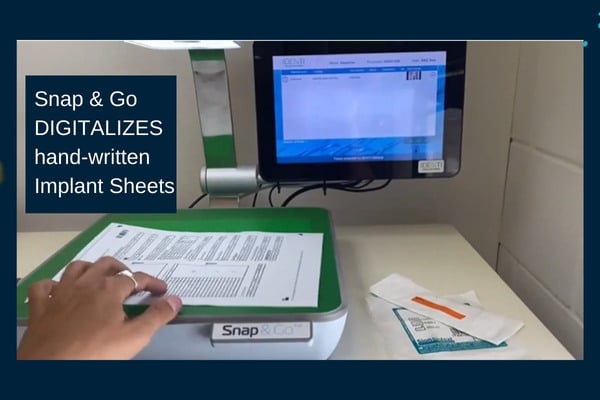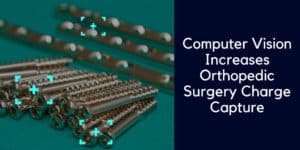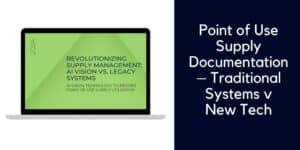What’s inside:
Ambulatory Surgery Centers (ASCs) using technology to improve item capture during surgery, are seeing a direct impact on clinical, operational and financial performance.
Read on to find out why:
- Healthcare inventory control is a vital component of ambulatory center management
- Orthopedic ASCs in particular, need to gain better control of their medical inventory
- Technology is providing solutions that have an organizational impact
Why gaining control of medical inventory matters
Ambulatory surgery centers can benefit greatly from automated medical inventory management solutions. ASCs using manual systems or outdated automation tools are putting themselves at a disadvantage when it comes to clinical, operational and financial efficiency.
There is one specialism, in particular, that has a lot to gain by tackling medical inventory inefficiencies – and that is orthopedics.
Orthopedic ASCs utilize a large, complex, and expensive range of medical inventory, and not all items are easy to track.
ASCs, and especially orthopedic surgery centers, have a lot to gain by using technology-driven solutions to improve the accuracy, speed, and efficiency of their implant tracking and medical inventory management.
Why control of medical inventory is a bigger issue for Orthopedic ASCs
The ASC sector is growing, and within the sector orthopedic surgery centers are on the rise. There is an increase in demand for this type of procedure and many patients are choosing the ambulatory care setting.
With increased competition orthopedic ASCs need to be on top of their game.
The issue of medical inventory management is particularly pertinent for the orthopedic healthcare providers. Orthopedic procedures are typically associated with high operating costs due to the expensive implants used for joint replacement procedures, as well as the wide range of other supplies associated with arthroscopic and spine surgery. There are several issues that are specific to orthopedic ambulatory care centers and hospital departments:
Orthopedic medical inventory
Orthopedic procedures are BIG in many ways when it comes to medical inventory.
- Many orthopedic implants and devices are high value items
- Orthopedic procedures tend to use a higher volume of inventory items than other surgeries.
- The surgeon requires a large variety of items available to select from during surgery – different types and sizes of implants and consumables.
This wide variety of medical inventory is a challenge to track and document. as different types of products can be problematic to capture in hospital systems.
Let’s find out why.
Non-stock items and consignment
Because there is such a wide range of inventory used in orthopedic surgery, it is difficult for ASCs to hold all items in stock.
When a patient requires a specific type or size of product that is not held in stock, the orthopedic surgeon may use a bill-only item provided by a vendor, who is on-site for the procedure.
Some surgery centers have consignment arrangements with vendors so that they don’t need to hold such large volumes of stock, but others rely on trunk stock to fill inventory gaps.
Non-stock items are not pre-loaded onto hospital systems but still need to be documented.
Orthopedic PPI
There is no consistency when it comes to physician preference items (PPI) and ASC leadership are starting to look at the varying cost of the same surgery. They are looking to reduce the variance in PPI, in order to achieve standardization and cost savings.
The starting point for this exercise is the ability to obtain accurate data that compares the cost of the same surgery for different physicians. The foundation beneath this data is achieving accurate point of use utilization and charge capture.
Orthopedic kits and trays
Something else that makes orthopedic procedures different from other surgeries is that they make use of orthopedic kits and trays. These are often non-sterile products that arrive in surgery after going through the hospital’s Sterile Processing Department. Alternatively, they could be delivered and assembled by the vendor. During surgery the physician will just select the specific items needed, in the required size, with the remainder of the kit being returned.
It is the task of the Circulating Nurse to document just those items used from the tray. There may be different quantities of consumables used and the nurse will need to record the correct quantity for each item. This task is often undertaken on a manual implant sheet and then needs to be keyed-in to the system.
Cross-organizational need for orthopedic supply chain data
Utilization data is vital information that feeds into other hospital systems. It is important to make sure that surgery documentation is a full and accurate record of all the items consumed.
However, due to the wide range of medical supplies used for orthopedic procedures, most point-of-use data capture tools just can’t cope with the complex range of items that need to be documented.
Usage data is not just an issue for the clinical team, and errors and omissions in this crucial information will have ramifications across the organization. Case documentation needs to capture the full range of reportable items used in surgery and this data then needs to be shared with other hospital systems, such as the EMR, ERP, and MMIS systems.
Surgical data capture needs to be complete and correct, as this information feeds into other hospital systems and workflows.
Summary of orthopedic medical inventory issues
Let’s take a moment to look at the three biggest issues that we have highlighted so far.
- Orthopedic surgery involves high value, complex medical inventory
- Non-stock items are often used, which are not listed on the Item Master
- Non-sterile implants can be particularly difficult to document
Orthopedic ambulatory care centers need to have robust systems and workflows in place that can meet the documentation challenges of ALL items used in surgery.
Why software for data capture struggles with orthopedic inventory
In order to achieve full charting and charge capture, it is vital that the Circulating Nurse achieves the full documentation of all billable items.
However, many surgical data capture systems struggle to cope with the documentation of some inventory items, for example, trunk stock, last-minute orders, items from orthopedic kits. When the point of use data-capture tool fails to capture item information in surgery, the nurse often reverts to the manual keying-in of data.
Even when the data is manually keyed-in there can still be problems, as some items cannot be read by the system.
This then triggers a longwinded process to getting the item recorded onto the system.
At each stage, there is room for error or omission, meaning that some items never make it onto the system.
The repercussions of incomplete data capture at the point of care
Incomplete or inaccurate item capture during surgery can have serious consequences.
- SAFETY:
- Gaps in utilization data mean that no digital record has been made to connect an implant and its recipient, which is non-compliant with FDA UDI regulations.
- Patient safety is compromised in the case of any future recall.
- Recall management becomes a long process involving manual record-checking, making it harder to trace all affected patients.
- REVENUE:
- Gaps in charge capture represent holes in the medical billing
- Items missing from medical billing means failure to achieve full reimbursement
- INVENTORY:
- Lack of item tracking means that the materials management team is not aware that stock has been used.
- This lack of inventory vision creates inventory errors that lead to inaccurate orders, stock-outs and surpluses.
- Stock surpluses lead to wastage, as items can end up expiring on the shelf.
- NURSES:
- Busy nursing staff are distracted by supply chain admin as they attempt to accurately document the case, when the patient and clinical team need support.
- To ensure optimum surgery turnover times, while one nurse continues to document the previous case in another room, a second nurse is often called upon to take over room preparation for the next patient. Turnover times need to be tight to optimize hospital income.
We can see that there are clinical, operational, and financial implications to inefficient item capture during surgery. So how can technology be used help to add efficiency and automation to orthopedic item capture during surgery?
Orthopedic surgical data capture solution
Point of use data capture should be quick and easy. But all too often it’s far from simple.
Some smaller ASCs don’t have an automated system and use manual keying-in, which is time-consuming and error-prone.
Some ambulatory care centers use point-of-use barcode scanning, which is unreliable as nurses often waste valuable surgery time looking for the correct barcode to scan among a multitude of barcode stickers on the packaging. Even when the correct label is found, the item may not scan properly, or the system may not record the full data required. All too often it’s back to the keying-in method.
And then there are all those non-stock items that aren’t on the system yet.
And the kits and trays that tend to get manually documented on implant sheets and then keyed into the system afterward, line by line.
Documenting the items used in surgery is complicated and all the items that aren’t easy to deal with during the procedure don’t get entered into the system. Then the nurse needs to play ‘catch-up’ after surgery and attempt to get all items onto the system.
Surely there’s an easier way?
Orthopedic perioperative software for data capture
By providing real-time item capture in the surgical setting, orthopedic perioperative software can help ambulatory centers to increase efficiency in the operating room. The right POU data capture technology can have a big impact.
For example, IDENTI’s Snap & Go has the following features:
Item Capture
- A fully automated and accurate point-of-use item capture
- Full visibility of inventory usage across departments, enabling accurate restocks and eliminating stock-outs and overstocking.
- Enhanced patient safety with FDA UDI-compliant implant tracking
- Increased efficiency in the operating room by optimizing the clinical workflow
- Reduced utilization admin for busy nurses
Charge Capture
- Full and accurate charge capture
- A streamlined billing process through accurate charge capture
- Accurate and timely billing resulting in optimum reimbursement
- Reduced financial costs due to improved charge capture and item tracking
These benefits make orthopedic perioperative software the perfect choice for any ambulatory center looking to improve data capture during surgery. But selecting the right tool can make all the difference.
New technology is now revolutionizing the automation of surgical data capture.

Orthopedic item capture during surgery
It seems a little crazy to point this out, but point-of-use data capture should actually take place at the point of use.
It shouldn’t require post-surgery admin followed by documentation audits as a final check.
Documentation should not be a manual process where screen after screen, field after field needs to be completed, risking incorrect entries and taking nurses away from patient care.
Since barcode technology and manual inputting are unreliable methods, it’s time for a fresh approach.
The next generation of data capture has arrived in the form of image recognition technology, AI, and machine learning. This powerful mix of technologies is revolutionizing the surgical documentation of cases.

Computer vision technology at the point of care
Computer vision technology will have ASCs throwing out their barcode scanners.
Item capture
Snap & Go uses patent-protected computer vision technology and is the brand-new approach to surgical data capture that the healthcare sector has been waiting for.
The Circulating Nurse just needs to take a quick ‘snap’ of each product’s packaging so that a digital image is recorded.
Once this is achieved, the nurse’s job is done, and the remainder of the process is automated.
One quick snap is all it takes to document all items.
Yes, ALL
Even stock items with an out-of-date listing on the Item Master!
Even non-stock items!
Snap & Go does not rely on the local Item Master and is able to identify all products, whether stock items or not.
But what about products that have no package such as items from kits and trays?
What makes Snap & Go so suitable for orthopedic surgery centers is its ability to record small consumables.
The nurse just needs to take a ‘snap’ of the hand-written implant sheet and the system then ‘reads’, interprets and documents every item. Finally, a simple way to get an accurate digital recording of items from non-sterile kits, sets and trays which can be so time-consuming and problematic to record.
By the end of surgery, the nurse will have achieved full and accurate charting.
Snap & Go’s image capture technology makes it easy to document usage during surgery and gets the job done without distracting busy nurses from their primary concern, patient care.

Let’s break down how ‘Snap & Go’ works.
Item identification
Snap & Go is powered by AI and machine learning software. The image of the item’s packet is interpreted by the software and the product is identified and documented in the EMR, ERP, and MMIS.
Item identification is quick and simple. The system taps into a global SKU database and as a final safety net, there is also a back-office service.
Snap & Go automates the item identification process, ensuring that every item is identified, even those not on the hospital Item Master.
Item validation
Did you know that item identification is not just about documentation? It is also about patient safety.
Nurses are the last line of defense in terms of patient safety at the point of care.
Following on from the item identification process, Snap & Go flags up any expired or recalled product. In doing so it provides pre-consumption validation of items, boosting patient safety and preventing catastrophic ‘never-events’.
Item data is vital, not just for surgical records or medical billing but also to safeguard patients.
Item documentation
Snap & Go enables ambulatory care centers to achieve 100% item and charge capture in their orthopedic procedure rooms, as well as all other surgical suites.
The system offers seamless integration with the ERP, EMR, and MMIS – ensuring that all that valuable usage data is fed into hospital systems.
Patient Charting
It reduces the role played by the nurse, their job is no longer to scan, identify and document each item – with Snap & Go they just need to take a quick ‘snap’ of item packaging and that’s it, job done! The system does the rest.
Snap and go supports quick and accurate:
- Item capture
- Item identification
- Item validation
- Item documentation
- Charge capture

The power of AI technology for data analytics
Automated medical inventory systems, such as point-of-use data capture technology, give healthcare providers tighter control of their medical inventory.
With orthopedic ASCs holding a large volume of high-value medical supplies, achieving inventory control is crucial.
Inventory control is all about visibility and data.
- When materials managers can gain a timely and accurate picture of usage, they can use this to support accurate restock orders and achieve a balanced inventory.
- When inventory levels are accurate, they prevent wastage through expiry.
- When perpetual stock is achieved inventory costs come down
- Technology is able to map trends and notice patterns to support informed forward planning of anticipated medical inventory needs – taking account of seasonal trends etc.
- Cost of surgery data broken down to the physician level can support conversations around variance, supporting the standardization of pick lists
- Areas of high expenditure can be noted
Data-driven decision-making – supported by system metrics, reports, and insights, enables healthcare providers to gain tighter control of resources, improve performance and become stronger competitors in the healthcare sector.
Let’s recap on the issues that Orthopedic ASCs and other healthcare providers often experience when managing point of use data, and see how Snap & Go provides a solution:
| Issue | Snap & Go Solution |
| Barcode scanning and manual-keying in can be time consuming and inefficient | Item Capture using computer vision takes just 3 seconds per item, plus it can digitalize handwritten Implant Sheets |
| Not all items are on the Item Master. Even if they are, some may contain out-of-date information, eg. batch number. Unless there is a match with the hospital system, the item cannot be scanned or entered. | Item Identification is automated and utilizes a global SKU database breaking away from reliance on the hospital Item Master. Details of exceptions that did not find a match on the hospital system, are provided in handy reports, that help the hospital to maintain the Item Master. |
| Recalled or expired items may end up in the procedure room | Item Validation provides a safety net, with pre consumption alerts which avert ‘never-events’ |
| Utilization recorded in surgery needs to be shared with hospital systems | Item Documentation in the EMR, ERP and MMIS is made possible due to seamless integration with hospital systems |
| All billable items need to reach the charge master. | Item Charge Capture takes place automatically, ensuring a full record of the items used in surgery will be included in medical billing. |
| Utilization data can be collected and analyzed to support decision making | Cloud software using AI and Machine Learning is able to produce real-time metrics, reports and data-insights to support day to day decision making and long-term planning |
The business impact of automated inventory management systems
Point-of-use automation is an essential element of any inventory management system, providing real-time inventory vision, item tracking and utilization data.
The digital revolution has laid the foundation for automated inventory management solutions that can add real value to an ambulatory care center, such as:
- enhanced patient care
- reduced wastage
- lower costs
- regulatory compliance
- optimized revenue.
By investing in a sophisticated and automated utilization data capture system, orthopedic ASCs can harness the power of technology to improve their clinical, operational and financial performance.
Orthopedic perioperative software is helping orthopedic ASCs to add speed, accuracy and efficiency to their medical supply chain workflows and this in turn will help to strengthen their position in the sector.
Image-recognition technology is the future of surgical utilization and Snap & Go takes data capture into the next era.
Contact us for a demo.






